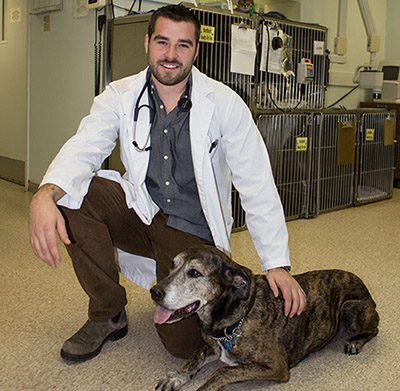With temperatures dropping, it is important to be mindful of our four-legged friends and change pet care routines to match the season.
We have all heard of summer news stories in which dogs have been left in cars with disastrous results. Freezing temperatures can be equally hazardous, according to Brad Dewar, communications officer for the Ontario Society for the Prevention of Cruelty to Animals (OSPCA).
What can start off a quick trip to the mall may take longer than expected and time slips away before the owner realizes how long the animal has been left out in freezing temperatures. It’s best to leave it at home according to Dr. Craig Etherington, veteranarian at Morningside Pet Hospital.
He has direct advice about leaving animals in the car: “There is not really any good time to leave a dog in the car is the bottom line.”
Dogs with prolonged exposure to freezing temperatures may also suffer frostbite. Etherington notes the ears are particularly vulnerable and, if the frostbite is severe, may need to be removed .
Cats can also get into trouble with cars during the winter months. Dewar explains they will often climb under the wheel wells or under the hoods to stay warm and can be seriously injured or die.
“Check for small animals hiding by banging around the hood and wheel wells of the car before starting it,” he said.
Salt used to reduce ice on walkways, roads and parking lots can irritate pets’ paws according to Derrick Zuber, one of the owners of Muddy Paws in the Guild.
“It dries out their skin and can cause cracked and sore areas,” he said.
Dewar suggests the dogs paws be protected to prevent further discomfort. Etherington suggested using boots to help safeguard your pet from salt and noted balms are also available for dogs who don’t tolerate boots.
Zuber sells both items in his store. He has a petroleum-based balm called Dr. Maggie’s that retails for $21. It hardens in the cold and then can be wiped off once the walk is over. He also sells two types of boots. One is a rubber latex models priced at $25 and can be worn again unless they are punctured by a dog nail. The other option is to buy the Kozy Paws brand for $45. They come with suede soles, fleece lining and a waterproof nylon shell.
Another hazard according to Dewar is anti-freeze used with salt as a de-icer. It attracts dogs because of its slightly sweet smell. Etherington explains it can cause kidney failure and “it is an emergency if they ingest any anti-freeze.”
Some dogs are also more susceptible to the cold says Etherington, especially short haired ones since they lack an undercoat. He always puts a sweater coat on his short-haired Great Dane mix, Charlie, before going out for a walk when it’s freezing outside.
Some owners prefer to leave their pets outside but there are legal requirements to be met. Dewar said owners are expected to keep their dogs tethered and left in an enclosed area. Owners are also obligated to provide a proper shelter; one that is insulated and is the appropriate size for the pet. Zuber sells heating pads, ranging in price from $90 to $150 each, ideal for putting under a blanket or dog bed. They help keep the animal warm and its water supply from freezing.
With company visiting your home, it’s important to give your pet a little breathing room and preferably not by leaving the animal outside for prolonged periods. The best thing to do, according to Dewar, is to keep pets in a separate room away from the guests. It will also prevent pets from getting outside and possibly getting run over.
Zuber echos the OSPCA recommendation noting the pets are “not usually around that many people at one time” and stress can be reduced by having the pet stay with a friend or relative. Etherington says a “quiet place away from any kind of toxins” is best. He suggested a boarding facility as another option to help keep your pet happy and cared for when there’s a crush of guests at home.
OSPCA’s Dewar notes two popular Christmas decorations can also be problematic for pets. One is the poinsettia that can cause gastric upset if ingested and can irritate the skin upon exposure. The other is burning candles since cats, given to climbing and hopping onto differences surfaces, have been known to knock them over and cause house fires.
One of the other pet hazards lurking during the holiday season is food. Chocolate with the compound theobromine is particularly toxic to pets.
According to Etherington, cats lack the ability to taste sweet things — they don’t have the taste buds required — and as a result are less apt to consume chocolate. Dogs, on the other hand, “will eat anything.” He explained symptoms range from vomiting and diarrhea to seizures and even death.
Dewar noted poultry bones, especially if they’re small can cause choking hazards for pets. Onions, often found in turkey gravy, are also unsafe. Etherington explains the vegetable is toxic since it interferes with red blood cells causing anemia.
To ensure your pet has a safe and happy winter, especially with the holidays coming up, make sure to protect it from the hazards of the season.













